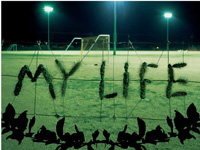Stefan Sagmeister

There is one sentence in the bio of Stefan Sagmeister that says both nothing and everything: "He has earned practically every important international design award." The bio does not continue on to list those awards, it just glides into other subject matter — much like a phrase your lawyer might insert to guard you from getting sued.
From a certain perspective, that statement is funny (because what more casual way to say you've kicked ass is there than to glaze over every accolade you've received), but in another way, it is potently telling. Stefan Sagmeister is an incredible designer — that much is clear — but his work and his lifestyle have made it abundantly clear where his heart is. It is in art, in simplicity, in communication and the universal nature of emotion. The last place it lives is a trophy shelf.
Design as religion (which is perhaps the most understandable way to describe Sagmeister's approach) is a far-fetched concept, but if you've stuck your face into his latest book, Things I Have Learned In My Life So Far, it is not as hard to imagine. Read on as we chat with Stefan about his studio, his opinions, and his willingness to depart from both from time to time in pursuit of a higher power.
 Joshspear.com: Your grandfather was a typographer, and that turned out to be your biggest passion as well. How much do you credit his influence on your being a designer?
Joshspear.com: Your grandfather was a typographer, and that turned out to be your biggest passion as well. How much do you credit his influence on your being a designer?
Stefan Sagmeister: I never knew him, I just grew up with much of his work in our apartment and hallway in Bregenz, Austria. The direct influence is difficult to gauge for me.
JS: You preach heartfelt, touching design. How do you go about personally pursuing this ideal?
 SS: By trying to do the same. Sometimes it works (usually when I’m strong), sometimes it does not.
SS: By trying to do the same. Sometimes it works (usually when I’m strong), sometimes it does not.
JS: All designers struggle with the art as work/work as art paradox. You, however, were brave enough to leave work to make sure you weren't losing sight of why you do what you do. Can you share with us a little bit about what you learned during that time?
SS: I assume you are talking about my client free experimental year. What came out of it:
1. I found my joy as a designer again.
2. I reorganized the direction of the studio, from a company that did mostly design for music into a much wider place where we pursue scientific, social, corporate and artistic design directions.
3. I learned about all the things I thought I wanted to do but, when given a chance, turned out I did not want to pursue them at all.
4. Much of the work that I am happy with that we have done since originated in that year.
 JS: Leaving work for a year certainly had its perks, not the least of them being your resulting journals — but did taking that time leave you with continuing benefits once you returned to the agency life, or did they fade away?
JS: Leaving work for a year certainly had its perks, not the least of them being your resulting journals — but did taking that time leave you with continuing benefits once you returned to the agency life, or did they fade away?
SS: See above. Continuing benefits, certainly! Which is why I institutionalized the year and am doing one every seven years.
JS: You've mentioned that the bigger an agency gets, the harder it is to have respect for it. Why do you think that so many big agencies fall into the "Big and Boring" hole?
SS: Three reasons I can think of: The general bureaucracy, the high overhead with the need to pay for it by taking on bad jobs, and the separation between the creative and client service departments.
 JS: The book you released recently, Things I Have Learned in My Life So Far, was unique in that most of its featured designs were brought to life out of very introspective, very personal thoughts and ideas. How did you sell "you" as creative concept?
JS: The book you released recently, Things I Have Learned in My Life So Far, was unique in that most of its featured designs were brought to life out of very introspective, very personal thoughts and ideas. How did you sell "you" as creative concept?
SS: This series grew — from one project to the other — slowly. The first client had a completely open brief, all they wanted was dividing pages for a magazine. The second client had the same open brief, in their case they needed billboards. By the time it became clear to me that this could be a series, we already had a track record of successfully published pieces, had gotten many reactions from viewers and therefore had an easier time selling the concept to new clients. By now numerous clients call who want a sentence from the diary specifically.
JS: I know you disagree that Saatchi's design work for Maragret Thatcher had much of a role in her becoming Prime Minister — do you feel similarly about the design that's been popping up within the Obama campaign?
 SS: Yes. I think it had almost no effect. Nevertheless, we might do some work for him.
SS: Yes. I think it had almost no effect. Nevertheless, we might do some work for him.
JS: What are some ways Sagmeister, the agency, has progressed this year?
SS: We were the author of more of our work then in past years and published a book aimed at people outside of the design industry. But the noticeable progress in design gets to be less clear cut as I go along. I loved the time when I was a design student and I so clearly got better at something every month.
JS: When will you take a year off again?
SS: I will be in Indonesia for my second client-free experimental year from September 1, 2008 through September 1, 2009.
